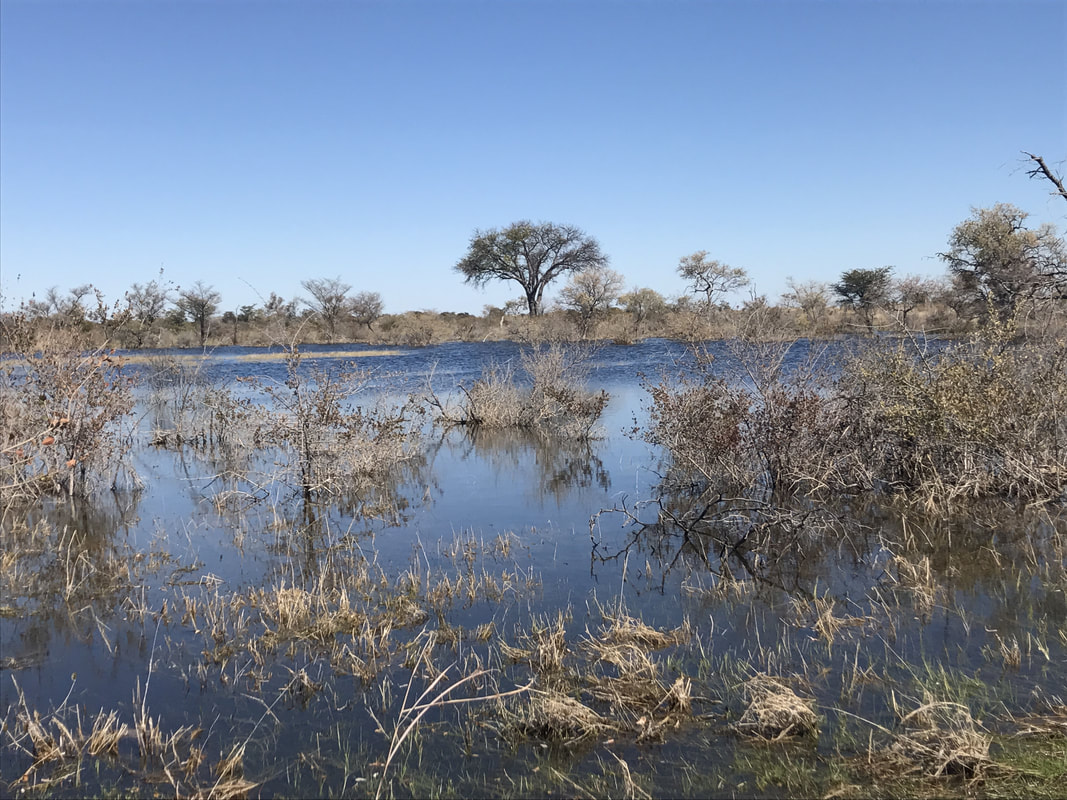 Drove 800 km north out of Windhoek, no problem. Passed ostrich, baboon, warthog, lilac-breasted rollers (no fire this time – see link), bee eaters, pale chanting goshawk and some exotic road signs. Then, disaster… we stopped overnight and I locked the keys for the hire car in the boot. I was informed a spare would take one week to reach me. Impossible. Also, the courier cost was prohibitive. “Break the window, remove the seat and pay for repairs,” advised Hertz. “Ag,no, what,” said Stephan, owner of the excellent Seiderap guesthouse in Grootfontein. “Lemme have a go.” So, between cooking delicious courses and topping up guest wine glasses, Stephan popped out with a bent wire and popped the lock. I can definitely recommend that stopover! The next afternoon we — I was with my trusty Kalahari travelling companion, Melissa Heckler, founding teacher of the Village Schools in Nyae Nyae. She was returning to expand the pre-school education project she’s started — drove into Tsumkwe, home to !Ah radio. With a floating population of approximately 1500, it’s the largest town in the arid Nyae Nye Conservancy. Amazingly, Tsumkwe looked like it had been plopped down into the Lake District. Green shrubs, green grass, large bodies of blue water, where before there’d been parched earth and bushes grey with dust. Coot and teal hooted and quacked as we drove over a section of road that was now a bridge. I spotted a turtle clambering up the trunk of a submerged tree. Where the heck had it been during the drought years? Next morning I called in at the NBC, was welcomed warmly, and immediately we were off to find the head of the traditional authority in the region, a man known affectionately as "Chief" Bobo. The chief was not in his usual abode. “He’s gone Bushmen,” his son, #Oma Leon quipped. He explained his father was out harvesting Kamaku, Devil’s Claw, a root sold to big pharma for use in countless health products. Kamaku is hell to harvest. The tell tale surface tendril is difficult to spot, and handling the prickly bulb lacerates the fingers. As natural ecologists, some say the world’s oldest, the Ju|’hoansi ensure the mother plant is left intact to grow next year’s crop. Digging Devil’s Claw is seasonal work and poorly paid, but it’s one of the few sources of income for many residents of the area. After a lot of off-road driving, we came upon four OAPS who were clearly in their happy place, a peaceful bush camp under lacy trees. The old wives sat under on the ground, legs outstretched, chatting and laughing as they sliced the murderous root. The chief’s brother-in-law whittled away at a new walking stick, fashioning a head of white much like his own. Tsamkxao ǂOma, Chief Bobo, received us graciously. To paraphrase the translation made for me: "He is thanking us for driving out to find him." Chief Bobo listened keenly as my interpreter outlined the project, then beaming through over-large blue plastic spectacles, he launched into a statesmanlike speech: “This khuitzima (lit. radio role play) is a very good opportunity for the Ju|’hoan to present their culture and talent to other people in Namibia, and even beyond Namibia. People must realize this work is long-term; it’s a project not just for them but for their children too....” Translation provided by Kallie N!ani Kagece of the Tribal Authority office 'Chief' Bobo asked me to visit as many Ju|’hoan villages as possible to get the approval and input of the people. Consensus is the San way. I agreed, little knowing how many there were and how arduous travel conditions would be over the next few weeks, in the soggy Kalahari desert.
0 Comments
Leave a Reply. |
AuthorAfrican novelist and out-to-grass, academic. Archives
January 2024
Categories
All
|
 RSS Feed
RSS Feed